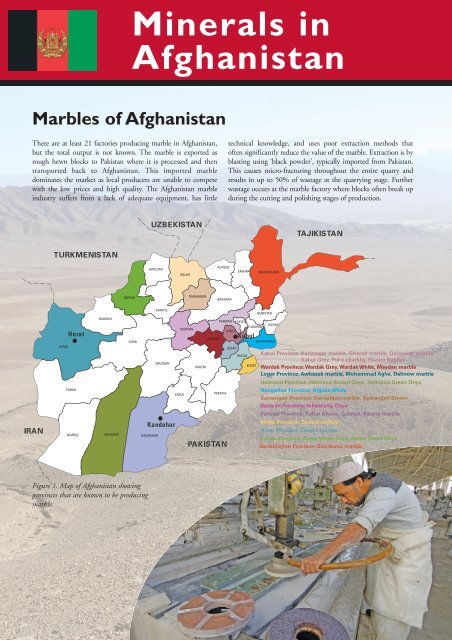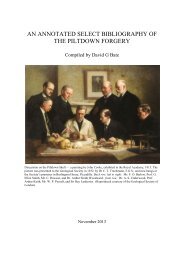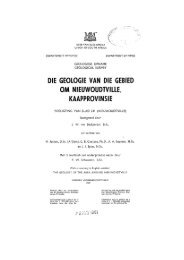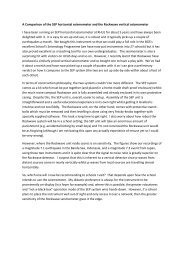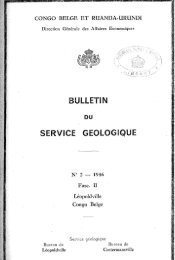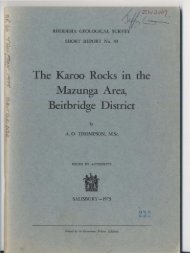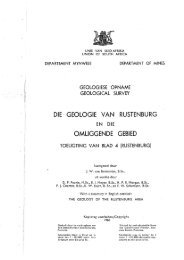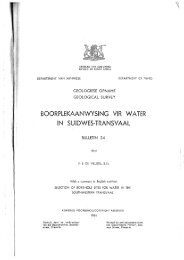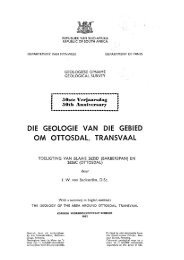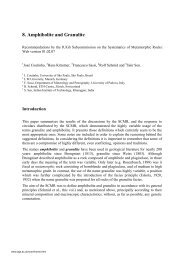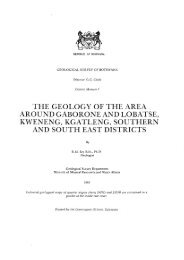Minerals in Afghanistan - British Geological Survey
Minerals in Afghanistan - British Geological Survey
Minerals in Afghanistan - British Geological Survey
You also want an ePaper? Increase the reach of your titles
YUMPU automatically turns print PDFs into web optimized ePapers that Google loves.
Marbles of <strong>Afghanistan</strong><br />
There are at least 21 factories produc<strong>in</strong>g marble <strong>in</strong> <strong>Afghanistan</strong>,<br />
but the total output is not known. The marble is exported as<br />
rough hewn blocks to Pakistan where it is processed and then<br />
transported back to <strong>Afghanistan</strong>. This imported marble<br />
dom<strong>in</strong>ates the market as local producers are unable to compete<br />
with the low prices and high quality. The <strong>Afghanistan</strong> marble<br />
<strong>in</strong>dustry suffers from a lack of adequate equipment, has little<br />
IRAN<br />
TURKMENISTAN<br />
HERAT<br />
Herat<br />
FARAH<br />
BADGHIS<br />
FARYAB<br />
GHOR<br />
JAWZJAN<br />
NIMROZ HELMAND KANDAHAR<br />
Figure 1. Map of <strong>Afghanistan</strong> show<strong>in</strong>g<br />
prov<strong>in</strong>ces that are known to be produc<strong>in</strong>g<br />
marble.<br />
<strong>M<strong>in</strong>erals</strong> <strong>in</strong><br />
<strong>Afghanistan</strong><br />
UZBEKISTAN<br />
SARIPUL<br />
URUZGAN<br />
Kandahar<br />
ZABUL<br />
BALKH<br />
BAMYAN<br />
SAMANGAN<br />
GHAZNI<br />
WARDAK<br />
KUNDUZ<br />
BAGHLAN<br />
PARWAN KAPISTA<br />
LAGHMAN<br />
KABUL<br />
PAKTIKA<br />
PAKISTAN<br />
technical knowledge, and uses poor extraction methods that<br />
often significantly reduce the value of the marble. Extraction is by<br />
blast<strong>in</strong>g us<strong>in</strong>g ‘black powder’, typically imported from Pakistan.<br />
This causes micro-fractur<strong>in</strong>g throughout the entire quarry and<br />
results <strong>in</strong> up to 50% of wastage at the quarry<strong>in</strong>g stage. Further<br />
wastage occurs at the marble factory where blocks often break up<br />
dur<strong>in</strong>g the cutt<strong>in</strong>g and polish<strong>in</strong>g stages of production.<br />
LOGAR<br />
TAKHAR<br />
Kabul<br />
PAKTIA<br />
KHOST<br />
BADAKHSHAN<br />
NURISTAN<br />
KUNAR<br />
NANGARHAR<br />
TAJIKISTAN<br />
Kabul Prov<strong>in</strong>ce: Karizmeer marble, Ghazak marble, Qalamkar marble,<br />
Kabul Grey, Pul-e-charkhy, Hazare Baghal<br />
Wardak Prov<strong>in</strong>ce: Wardak Grey, Wardak White, Maydan marble<br />
Logar Prov<strong>in</strong>ce: Awbazak marble, Mohammad Agha, Dehnow marble<br />
Helmand Prov<strong>in</strong>ce: Helmand Brown Onyx, Helmand Green Onyx<br />
Nangarhar Prov<strong>in</strong>ce: Afghan White<br />
Samangan Prov<strong>in</strong>ce: Samangan marble, Samangan Brown<br />
Bamyan Prov<strong>in</strong>ce: Yakawlang Onyx<br />
Parwan Prov<strong>in</strong>ce: Kaftar Khana, Qalatak, Salang marble<br />
Khost Prov<strong>in</strong>ce: Zurmat marble<br />
Herat Prov<strong>in</strong>ce: Chesht marble<br />
Faryab Prov<strong>in</strong>ce: Almar White Onyx, Almar Green Onyx<br />
Badakhshan Prov<strong>in</strong>ce: B<strong>in</strong>i-Kama marble
The result is a relatively poor quality polished marble with a<br />
comparatively high unit cost of production.<br />
There is a wide variety of marble <strong>in</strong> <strong>Afghanistan</strong> currently<br />
extracted from quarries <strong>in</strong> Badakhshan, Balkh, Bamyan,<br />
Helmand, Herat, Kabul, Kandahar, Logar, Faryab, Wardak,<br />
Nangarhar, Paktia, Parwan and Samangan prov<strong>in</strong>ces. Marbles<br />
developed <strong>in</strong> rocks of Proterozoic age are considered to be the<br />
highest quality for use as dimension stone. Marble deposits<br />
<strong>in</strong>clude the follow<strong>in</strong>g:<br />
● Kabul Prov<strong>in</strong>ce. Proterozoic marble is quarried <strong>in</strong> Ghazak,<br />
Hazare Baghal, Kariz-Amir, Pul-e-Charkhy, Qalamkar, and<br />
Tara Kheel. The Proterozoic Kariz-Amir marble occurs<br />
approximately 40 km north of Kabul and consists of<br />
granular white, rarely grey-yellow marble. The Ghazak<br />
marble (known as ‘Ghazak Black’) is a popular f<strong>in</strong>egra<strong>in</strong>ed,<br />
black marble that occurs 32 km east of Kabul.<br />
● Logar Prov<strong>in</strong>ce. Proterozoic marble is quarried <strong>in</strong><br />
Awbazak, Dehnow and Mohammad Agha. Awbazak<br />
marble is bioclastic and brown <strong>in</strong> colour; Dehnow marble<br />
is brecciated and brown <strong>in</strong> colour; Mohammad Agha<br />
marble is black and white <strong>in</strong> colour.<br />
● Wardak Prov<strong>in</strong>ce. The Proterozoic Maydan marble occurs<br />
near Maydan Shar and consists of grey and dark grey<br />
marble ‘beds’ up to 450 m thick, <strong>in</strong>terbedded with schist.<br />
The ‘Maydan Marble M<strong>in</strong>es’ are well known, with five<br />
Ornamental marble work<strong>in</strong>g <strong>in</strong> Kabul.<br />
work<strong>in</strong>g areas <strong>in</strong> a 10–12 km outcrop that has been<br />
worked for 40 years.<br />
● Badakhshan Prov<strong>in</strong>ce. The Silurian-Devonian B<strong>in</strong>i-Kama<br />
marble consists of medium and coarsely crystall<strong>in</strong>e marble;<br />
the resource is estimated as 1300 million tonnes.<br />
● Herat Prov<strong>in</strong>ce. The Proterozoic Chesht-i-Sharif marble<br />
occurs 120 km east of Herat city and consists of a f<strong>in</strong>ely<br />
crystall<strong>in</strong>e marble rang<strong>in</strong>g <strong>in</strong> colour from pure white to a<br />
subtle light green.<br />
● Nangarhar Prov<strong>in</strong>ce. The Proterozoic Khogiani marble<br />
occurs 35 km south-west of Jalalabad and consists of a<br />
white marble known as ‘Afghan White’.<br />
Onyx marble. Onyx is a banded variety of chalcedony, a<br />
cryptocrystall<strong>in</strong>e form of quartz. Onyx is highly valued as a high<br />
quality marble and the colour of its bands range from white to<br />
almost every other colour. Afghan onyx is quarried from several<br />
prov<strong>in</strong>ces <strong>in</strong>clud<strong>in</strong>g Bamyan, Helmand and Faryab, with<br />
colours <strong>in</strong>clud<strong>in</strong>g shades of yellow, green or brown. Some of<br />
these may <strong>in</strong> fact be a variety of aragonite (calcium carbonate)<br />
called travert<strong>in</strong>e, however the traditional name of onyx has<br />
rema<strong>in</strong>ed <strong>in</strong> place and is still used to this day.<br />
The Chesht and Khogiani marbles are currently worked for<br />
dimension stone and have been favourably compared to<br />
Carrara marble, an Italian marble recognised to be one of the<br />
f<strong>in</strong>est <strong>in</strong> the world.
Karizmeer marble, Kabul.<br />
Kabul Grey, Kabul.<br />
Ghazak Marble, Kabul.<br />
Pul-e-charkhy, Kabul.<br />
Qalamkar marble, Kabul.<br />
Ghazak Black, Kabul.
Hazare Baghal, Kabul.<br />
Zurmat marble, Khost.<br />
Dehnow marble, Logar.<br />
Chesht-i-Sharif marble, Herat.<br />
Mohammad Agha, Logar.<br />
Awbazak marble, Logar.
Wardak Grey, Wardak.<br />
Wardak White, Wardak.<br />
Samangan Brown, Samangan.<br />
Wardak White, Wardak.<br />
Wardak Grey, Wardak.<br />
Samangan marble, Samangan.
Samangan marble, Samangan.<br />
Salang marble, Parwan.<br />
Helmand Brown and White Onyx, Helmand.<br />
Kaftar Khana, Parwan.<br />
Qalatak marble, Parwan (Panjshir).<br />
Helmand Brown and White Onyx, Helmand.
Helmand Brown Onyx, Helmand.<br />
Yakawlang Onyx, Bamyan.<br />
Almar White Onyx, Faryab.<br />
Helmand Green Onyx, Helmand.<br />
Khogiani marble (Afghan White), Nangarhar.<br />
Almar Green Onyx, Faryab.
F<strong>in</strong>ished marble products at a factory shop <strong>in</strong> Kabul.<br />
Contact details<br />
For further <strong>in</strong>formation please contact:<br />
Secretariat for the M<strong>in</strong>istry of M<strong>in</strong>es,<br />
Kabul,<strong>Afghanistan</strong><br />
Tel: +93 (0) 70 269 772/70 085 364<br />
e-mail: MMIAFG@hotmail.com or MMIAFG@gmail.com<br />
<strong>Afghanistan</strong> Project Manager, <strong>British</strong> <strong>Geological</strong> <strong>Survey</strong>,<br />
K<strong>in</strong>gsley Dunham Centre, Keyworth, Nott<strong>in</strong>gham<br />
NG12 5GG United K<strong>in</strong>gdom<br />
Tel: +44 (0) 115 936 3100<br />
e-mail: afghanistan@bgs.ac.uk<br />
or<br />
BGS Project Leader, BGS Kabul<br />
Tel: +93 (0) 799 136 140 e-mail: afghanistan@bgs.ac.uk<br />
© <strong>Afghanistan</strong> <strong>Geological</strong> <strong>Survey</strong>


